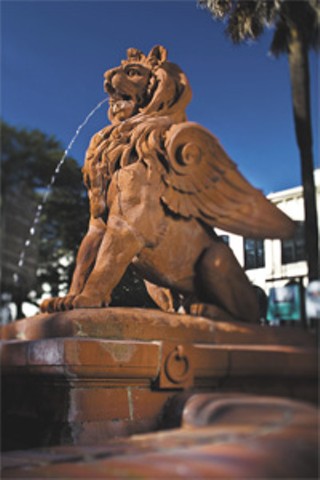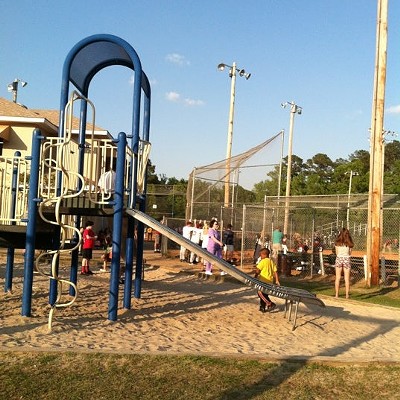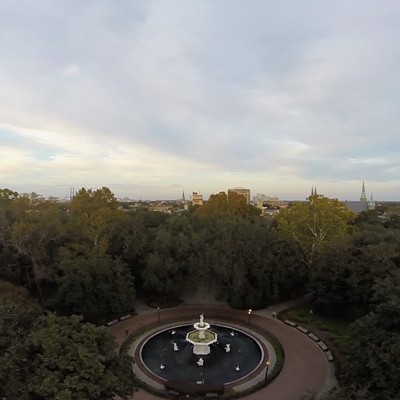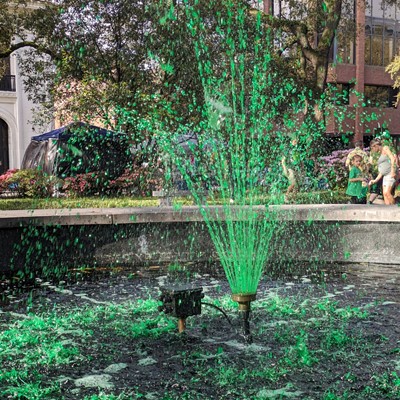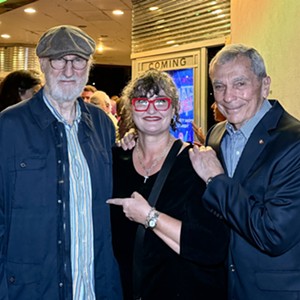IN A CITY as historic as this one, it’s often too easy to take things for granted.
Consider the many monuments that dot Savannah’s landscape. Some seem as old as time itself, and it’s almost impossible to imagine one disappearing forever.
But on Aug. 30, one of Savannah’s most beloved statues was smashed to bits by a drunken driver. The terra cotta winged lion — a symbol of Mark the Evangelist — that once stood in front of the Cotton Exchange was gone, seemingly forever.
Since 1889, the lion had stood guard, endlessly spouting water into a fountain below. The tips of the lion’s wings had accidentally broken off in 2005, but repairs had been made.
Joseph Marinelli, president of the Savannah Convention and Visitors Bureau, and his 7-year-old son, Alex, happened on the scene an hour after it occurred. “We could see that it was a police site, but we didn’t know what had happened,” Marinelli says.
“I pulled over to find out what was going on. Quite frankly, it was hard to absorb it all at first,” he says. “As one of the police described it, it’s the type of thing that only happens in the movies.”
Alex was devastated. “He loved throwing coins into the fountain,” Marinelli says. “We’ve had lots of friends and family visit us and one of his favorite things was standing on the bench in front of the winged lion for photographs.”
Roger Youmans remembers riding the bus with his mother as a child and passing the Cotton Exchange. “I couldn’t wait to go downtown to Bay Street to see the lion,” he says. “Most people who have lived here all their lives remember it as ‘the red lion.’”
After police received toxicology reports, Donna Haddock was charged with DUI, failure to maintain lane, no insurance and two red light violations. Investigators said she was driving north on Drayton Street about 7:15 a.m. when her car left the roadway at Bay Street.
First, the car plowed through the wrought iron fence, then smashed into the lion and its fountain. At some point, the car went airborne and Haddock took out a lamp post on her way to hitting the Cotton Exchange.
The car was found belly-up, and the Jaws of Life were required to pull Haddock from the wreckage. Incredibly, her injuries were minor, and she was treated at Memorial University Medical Center.
For days afterward, pieces of terra cotta and wrought iron were found all around the area. Three windows at the Cotton Exchange were smashed by debris and the front door was damaged from the car’s impact.
Citizens and visitors alike were outraged. “I’ve worked in City Hall close to 30 years,” says Glenda Anderson, director of the city’s Research Library and Archives. “I almost never leave the building that there isn’t someone taking a photograph of the lion or having someone take a photograph of them with it. It’s one of the most beloved downtown icons we have.”
City staff immediately began searching for ways to repair the lion or replace it. “I was looking for one of two things — if there was another red lion like it still standing that we could locate, or in absence of that, any records of the company that built it and might have original plans,” Anderson says. “I came up empty-handed on both counts, even though I spent probably two weeks doing nothing but making contacts.”
The search soon spread throughout the country. “We contacted the Apheneum of Philadelphia, the Friends of Terra Cotta, the Port Amboy Public Library, the Fine Arts Library of Boston, the Winterhtur Museum in Delaware,” Anderson says. “I called the Staten Island Historical Society in New York. We called the University of Texas at Austin and the Smithsonian American Art Museum, which has records on American sculpture.”
Nothing — and then a ray of hope. Anderson learned that the St. Louis Building Arts Foundation had in its collection a scrapbook with 235 illustrations of molds used by the Perth Amboy Terra Cotta Co.
“This is my saddest story,” she says. “The foundation’s building is currently under renovation, and the whole collection is totally inaccessible until fall 2009. Their archivist and I both cried when she told me.”
Anderson did learn that the statue was made by the Perth Amboy Terra Cotta Co. of New Jersey. It was featured in the company’s 1889 catalogue of outdoor art and decorations and originally cost just $173. “It was a stock item,” Anderson says.
Conservators from Oberlin, Ohio, who had worked with the lion previously, were called in. “They said, ‘Yes, we think you can put the fragments back together and build another mold,’” Anderson says.
David White, director of the city’s Parks and Trees Department, says work has already begun. “We’re in the process of advertising for a conservation consultant to restore the lion,” he says. “We’ll select someone who can do a good job of restoring or replicating the fountain.”
The lion probably was never expected to last as long as it did. “Terra cotta is not a really strong material,” White says. The project will likely take months, with cost estimates ranging from $60,000 to $70,000, White says. “Our risk management department is going to try to recover the cost.”
Like others, White was shocked by the accident. “I was really sad that something irreplaceable had been destroyed,” he says. “I guess we need to get people to slow down or be more careful. I think the problem is that alcohol was involved.”
This isn’t the first time city monuments and misbehaving citizens have mixed with disastrous results. In October 2004, a pickup truck driver drove through Troup Square, smashing into the armillary sphere located there and knocking it off its base.
Vandals then stole several of the gold-plated zodiac signs from the armillary, and damage totalled more than $42,000. Repairs took months.
On March 31 of this year, a Ford Mustang driven by a soldier from Fort Stewart took out a 15-foot section of the cast-iron fence that surrounds the Colonial Park Cemetery. It had to be replaced and a gravestone dating to 1827 had to be repaired.
Even months after the latest accident, observers wonder how on earth it happened. “We’ve all looked at the fire hydrants, poles, trees, all the things that should have stopped her,” Anderson says. “There were all these things she could have hit. I can’t figure out how she got around it all. Thank goodness it happened early on Saturday, or it would have been people in the way.”
Youmans, owner of Youmans Mobile Welding Inc., is repairing the fence. He located identical fencing at attorney Sam Inglesby’s office on McDonough Street, weeks before the accident. The fence came from the old Wetter House, torn down years ago to make way for a car dealership.
“I asked Mr. Inglesby if I could use it,” Youmans says. “He said, ‘This is my town, I’d love for you to use it to recast the fence.’
Youmans’ specialty is working with antique iron and he has done several projects at historic sites, including the Andrew Low House. This project is a little more complicated than others Youmans has done.
“Everything has to be as close as possible to the original,” he says. “When they were created, the castings weren’t perfect. That’s the nature of a casting. Parts like these are 3-dimensional, so there’s no such thing as a machine shop doing this.”
Everyone wants to see the statue restored, Marinelli says.
“Our staff has been fielding a number of questions from visitors asking, ‘What happened to the winged lion?’ I really think that it’s things like the lion that bring people here,” he says.
“Personally as well as professionally, I will do everything I can to help the city recapture the lion for the next 270 years.” cs

